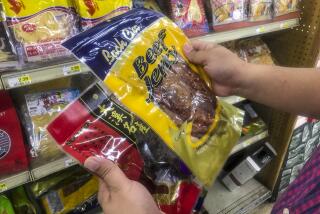Snake-Soup Business Is Slithering Away
- Share via
HONG KONG — Nothing holds off Hong Kong’s winter chill like a hearty bowl of snake soup, at least according to its devotees. But there’s a problem: Many restaurants are missing the main ingredient.
Hong Kong’s snake industry is suffering a severe supply crunch after Mainland authorities banned exports during the SARS outbreak, when research suggested that the respiratory illness was spread by wildlife in southern China.
The global epidemic was declared under control in July, and snakes have received a SARS-free bill of health, but the ban still stands. Chinese officials have told Hong Kong snake dealers that it’s a conservation measure linked to a spike in Mainland consumption, but the merchants aren’t so sure.
Some suspect that they’re victims of an overly cautious bureaucracy.
At China’s State Forestry Administration, which holds final say over shipments, a spokesman who identified himself only by the surname Liang told a reporter by telephone that he had no information on the ban.
But it’s definitely felt in the former British colony, where love of exotic food is said to include anything whose back faces the sky.
“I don’t see it served anywhere. It doesn’t seem like restaurants are coming out with any promotional packages,” said Vincent Li, 26, a financial consultant whose company hosts snake dinners for employees every year.
China is Hong Kong’s top source of snakes, shipping about 67,000 every year, and traders are having to defrost last year’s leftovers and import snakes from Southeast Asia at prices up to 20% higher. Some restaurants normally keep snakes coiled up in cages, ready to be killed and cooked on demand. But this season, many are dropping snake from the menus.
Snake aficionados view the meat as a winter-warming food, even an aphrodisiac. “It tastes great,” Li said. “It’s good for your body.”
Most of Hong Kong’s 130-odd snake shops go by the name Shie Wong, which translates as “Snake King.” There’s also a “Snake Queen,” Chau Ka-ling, who earned her nickname by helping officials capture wild snakes. She reports that sales at her eatery are off 70% from last year. “With the Mainland batch in limbo, people think there’s no fresh snake meat at all,” she said.
Snake gall is used for wine or cough drops, snakeskin for belts. Chau leaves little of the serpent unused. And not just snakes.
Law Oi, 73, stopped to pick up four frozen gecko lizards for a potion she believed would clear up her grandson’s cough. She also tucked into a bowl of soup boiled with snake bone and turtle.
Law also believes that snake can help soothe her itchy skin.
Savoring his weekly bowl of snake meat slivers, customer Lam Ram, 50, declared it better than chicken. “When it’s chilly, it warms up your body,” he said.
Chau said she is paying more for imported serpents but is holding her prices down until Hong Kong’s economic slump ends. An average snake meal in Hong Kong costs $3.30, about the same as a bowl of noodle soup.
“People’s buying power is still very weak,” she said.
Another merchant, Kam Oi-ho, said that if supplies didn’t resume soon, snake shops could go under.
“Nowadays, there’s no room for price hikes,” he said.
Serpents apparently had nothing to do with SARS, which claimed 299 lives in Hong Kong, but some are avoiding snake anyway.
“People don’t eat ‘wild flavor’ these days,” said K. Yip, a Chinese restaurant manager. His restaurant isn’t serving its usual snake meal, which he says is a shame because it’s a winter institution that builds neighborhood camaraderie.
“This year, the atmosphere hasn’t been that good,” he lamented.
More to Read
Sign up for Essential California
The most important California stories and recommendations in your inbox every morning.
You may occasionally receive promotional content from the Los Angeles Times.













